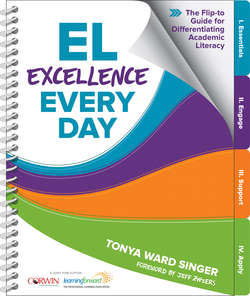Читать книгу EL Excellence Every Day - Tonya Ward Singer - Страница 50
На сайте Литреса книга снята с продажи.
3. Prioritize High-Level Thinking Tasks
ОглавлениеMake high-level thinking tasks a priority for all students. Remember that perfect English language use is not a prerequisite for high-level academic tasks. When an EL uses English imperfectly in the context of a high-level task, don’t replace that task with back-to-basics grammar. Instead, encourage the imperfections that are a natural part of students stretching their cognitive and communicative skills, and then listen closely to gather formative data about student assets and challenges. Use this information to plan strategic scaffolds and personalize teaching so ELs thrive with both your high-level tasks and the language they need to effectively communicate their thinking with impact.
“ELs at all proficiency levels are capable of high-level thinking and can engage in complex, cognitively demanding social and academic activities requiring language as long as they are provided appropriate linguistic support.”
—California State Board of Education (2012)
Higher-order thinking questions are important not just for the intellectual rigor but for relevance. Most higher-order questions are open-ended, meaning they do not have one right answer. A question such as “What is the author’s message in this story?” invites multiple, diverse perspectives. Be open to students having different opinions than you and drawing different inferences from texts based on their own life experiences and cultures. When you ask high-level thinking questions and invite multiple points of view, classroom discussions get interesting! Justifying ideas with evidence becomes a relevant task important for explaining and clarifying thinking. Through higher-level discussions that invite diverse interpretations, you value the unique assets all students bring to their learning. You create a space for every voice in your community of scholars.
Also critical for maintaining high expectations, use scaffolds strategically! When engaging ELs in high-level tasks, use scaffolds to ensure all students can participate, but don’t overscaffold. Only use what a student needs. Flip to Section III to learn the core philosophy and strategies for strategic scaffolding, which is central to teaching with high expectations.
